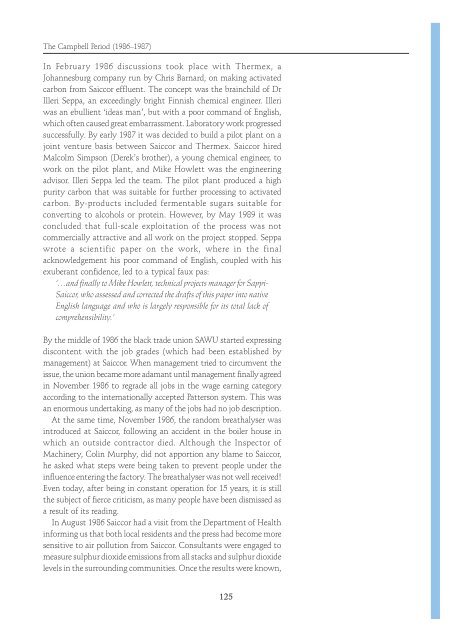You also want an ePaper? Increase the reach of your titles
YUMPU automatically turns print PDFs into web optimized ePapers that Google loves.
<strong>The</strong> Campbell Period (1986–1987)<br />
In February 1986 discussions took place with <strong>The</strong>rmex, a<br />
Johannesburg company run by Chris Barnard, on making activated<br />
carbon from <strong>Saiccor</strong> effluent� <strong>The</strong> concept was the brainchild of Dr<br />
Illeri Seppa, an exceedingly bright Finnish chemical engineer� Illeri<br />
was an ebullient ‘ideas man’, but with a poor command of English,<br />
which often caused great embarrassment� Laboratory work progressed<br />
successfully� By early 1987 it was decided to build a pilot plant on a<br />
joint venture basis between <strong>Saiccor</strong> and <strong>The</strong>rmex� <strong>Saiccor</strong> hired<br />
Malcolm Simpson (Derek’s brother), a young chemical engineer, to<br />
work on the pilot plant, and Mike Howlett was the engineering<br />
advisor� Illeri Seppa led the team� <strong>The</strong> pilot plant produced a high<br />
purity carbon that was suitable for further processing to activated<br />
carbon� By-products included fermentable sugars suitable for<br />
converting to alcohols or protein� However, by May 1989 it was<br />
concluded that full-scale exploitation of the process was not<br />
commercially attractive and all work on the project stopped� Seppa<br />
wrote a scientific paper on the work, where in the final<br />
acknowledgement his poor command of English, coupled with his<br />
exuberant confidence, led to a typical faux pas:<br />
‘…and finally to Mike Howlett, technical projects manager for <strong>Sappi</strong>-<br />
<strong>Saiccor</strong>, who assessed and corrected the drafts of this paper into native<br />
English language and who is largely responsible for its total lack of<br />
comprehensibility�’<br />
By the middle of 1986 the black trade union SAWU started expressing<br />
discontent with the job grades (which had been established by<br />
management) at <strong>Saiccor</strong>� When management tried to circumvent the<br />
issue, the union became more adamant until management finally agreed<br />
in November 1986 to regrade all jobs in the wage earning category<br />
according to the internationally accepted Patterson system� This was<br />
an enormous undertaking, as many of the jobs had no job description�<br />
At the same time, November 1986, the random breathalyser was<br />
introduced at <strong>Saiccor</strong>, following an accident in the boiler house in<br />
which an outside contractor died� Although the Inspector of<br />
Machinery, Colin Murphy, did not apportion any blame to <strong>Saiccor</strong>,<br />
he asked what steps were being taken to prevent people under the<br />
influence entering the factory� <strong>The</strong> breathalyser was not well received!<br />
Even today, after being in constant operation for 15 years, it is still<br />
the subject of fierce criticism, as many people have been dismissed as<br />
a result of its reading�<br />
In August 1986 <strong>Saiccor</strong> had a visit from the Department of Health<br />
informing us that both local residents and the press had become more<br />
sensitive to air pollution from <strong>Saiccor</strong>� Consultants were engaged to<br />
measure sulphur dioxide emissions from all stacks and sulphur dioxide<br />
levels in the surrounding communities� Once the results were known,<br />
125

















